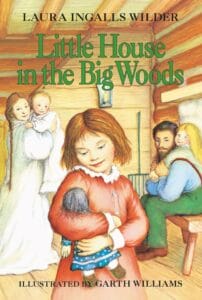
Book Summary
Little House in the Big Woods is an exciting and heartwarming book written by Laura Ingalls Wilder. It takes us on a journey back in time to the 1870s, where we get to meet Laura and her family and learn about their life in the big woods of Wisconsin.
This book is full of amazing adventures and interesting stories about Laura’s daily life. It is a perfect blend of history and imagination that will keep you hooked from beginning to end. You will get to experience the joy of making maple syrup, the thrill of hunting with Pa, and the coziness of spending time with Ma and Mary.
Little House in the Big Woods is a beautifully written book that transports you to a different era. Laura Ingalls Wilder’s descriptive language makes you feel like you are right there with her, experiencing everything she does. The book is filled with details about how Laura’s family survives in the wilderness, from making their own clothes to preserving food for the winter.
One of the things that makes this book special is the strong bond between Laura and her family. They work together, support each other, and find joy in the simplest things. Through Laura’s eyes, we learn about the importance of family, hard work, and gratitude.
Laura Ingalls Wilder was born in 1867 and grew up in the Midwest. She wrote the Little House series based on her own experiences as a pioneer girl. Laura’s books have become beloved classics, cherished by readers of all ages. Her stories continue to inspire and teach us about the history of our country.
“Little House in the Big Woods” is a classic children’s novel written by Laura Ingalls Wilder. Published in 1932, it is the first book in the “Little House” series, which is based on Wilder’s childhood in the American Midwest during the late 19th century. The book is a rich tapestry of family life, survival, and the pioneering spirit that characterized the American frontier. It is a timeless tale that has captivated generations of readers with its vivid depiction of life in the Wisconsin woods.
“Little House in the Big Woods” is a charming and engaging story that offers a glimpse into a bygone era. The narrative is simple yet captivating, and the characters are well-drawn and relatable. The protagonist, Laura, is a lively and curious girl whose perspective brings the story to life. Her interactions with her family, particularly her father, are heartwarming and provide a strong emotional core to the story.
The book is filled with detailed descriptions of the daily life and routines of the Ingalls family. From the chores they perform to the food they eat, the reader is immersed in the world of the American frontier. The book also includes several instances of folklore, songs, and stories that the family shares, adding depth and richness to the narrative.
One of the most striking aspects of “Little House in the Big Woods” is its depiction of the harsh realities of frontier life. The Ingalls family faces numerous challenges, from harsh winters to the threat of wild animals. Yet, they also find joy and contentment in their simple lifestyle. This balance between hardship and happiness gives the story a sense of realism and authenticity.
“Little House in the Big Woods” is more than just a children’s book. It is a historical document that offers valuable insights into the American frontier era. The book’s detailed descriptions of pioneer life, from the labor-intensive process of making cheese to the dangers of hunting, provide a vivid picture of the challenges and rewards of frontier living.
The book also explores themes of family, community, and self-reliance. The Ingalls family is a tight-knit unit that relies on each other for survival. They also depend on their neighbors for support and companionship, highlighting the importance of community in frontier life. The theme of self-reliance is also prominent, as the family must rely on their skills and resourcefulness to survive.
The narrative style of “Little House in the Big Woods” is straightforward and unpretentious, reflecting the simplicity of the Ingalls’ lifestyle. Yet, it is also filled with warmth and humor, making it a delightful read for children and adults alike.
Laura Ingalls Wilder was born in 1867 in Wisconsin, the setting of “Little House in the Big Woods”. She spent her childhood traveling across the American Midwest with her family, experiences that would later inspire her “Little House” series. Wilder began writing in her forties, initially penning articles for local newspapers and magazines. It wasn’t until she was in her sixties that she wrote “Little House in the Big Woods”, the first of her eight “Little House” books.
Wilder’s books have been beloved by generations of readers for their vivid depiction of pioneer life and their timeless themes of family, community, and self-reliance. Despite the many years that have passed since their publication, the “Little House” books remain relevant and engaging, a testament to Wilder’s skill as a storyteller and her deep understanding of the human spirit.
Don Quixote by Miguel de Cervantes
Miguel de Cervantes
Read Now →